 LIMITED SPOTS
All plans are 30% OFF for the first month! with the code WELCOME303
LIMITED SPOTS
All plans are 30% OFF for the first month! with the code WELCOME303

 LIMITED SPOTS
All plans are 30% OFF for the first month! with the code WELCOME303
LIMITED SPOTS
All plans are 30% OFF for the first month! with the code WELCOME303


Managing revenue recognition in today’s fast-paced, subscription-driven economy is more than a back-office function—it's a strategic imperative. With evolving standards like ASC 606 and IFRS 15, increasing deal complexity, and a growing reliance on usage-based models, finance teams face mounting pressure to get it right.
That’s why modern businesses are turning to intelligent platforms like Zenskar, which unify subscription billing and revenue recognition to reduce errors, improve compliance, and provide real-time financial insights. While Zenskar leads this space with automation-first infrastructure, the need for smart revenue recognition tools applies to every growing company navigating modern financial complexity.
Smart revenue recognition platforms address this by automating every step of the process. Once a contract is signed and billing terms are defined, these systems generate revenue schedules that align with performance obligations and real-time usage. If a customer downgrades mid-cycle or a milestone is met early, the system instantly updates the associated revenue without the need for manual intervention.
This level of automation significantly reduces the risk of human error and ensures consistency across every contract and customer. More importantly, it frees finance teams from routine tasks, allowing them to focus on forward-looking initiatives such as growth forecasting, pricing strategy, and cross-functional planning. Adopting financial automation not only streamlines revenue recognition and reporting but also accelerates the financial close process, enhances compliance, and provides real-time visibility into key metrics for more informed decision-making.
One of the biggest challenges in revenue recognition is ensuring compliance with financial reporting standards. Manual processes often result in inconsistent application of revenue rules and a lack of documentation when auditors come calling. Smart platforms are built with compliance at their core. They apply rules consistently across the organization, maintain a full audit trail of every recognition event, and make it easy to generate reports that align with regulatory requirements.
This not only improves audit readiness but also builds trust among stakeholders, from board members to external investors.


Traditional financial reporting is backward-looking. By the time reports are finalized, the insights are often outdated. Smart revenue recognition platforms flip this model by providing real-time dashboards and analytics that show how much revenue has been recognized, what’s deferred, and what’s forecasted. Decision-makers gain an up-to-date picture of financial health, enabling faster, more informed business decisions.
With real-time visibility, teams can spot trends earlier, respond to changes in customer behavior, and identify revenue leakage before it impacts the bottom line.
As companies scale, so do the challenges of managing revenue. New products, pricing models, currencies, and geographies all introduce additional layers of complexity. Legacy systems are often inflexible, requiring costly customizations or manual workarounds to accommodate change.
In contrast, modern revenue recognition platforms are built for scalability. They support multi-entity structures, global operations, and seamless integration with CRMs, ERPs, and billing systems. This means businesses can grow confidently, knowing that their financial operations won’t become a bottleneck.
Revenue recognition data isn’t just for accounting—it’s a strategic asset. When captured and organized correctly, it provides insight into customer behavior, product performance, and business trajectory. As experts from Randall Wealth Group explain, understanding how revenue patterns correlate with client behavior is crucial not only for corporate planning but also for building adaptable long-term financial strategies across industries. Finance teams can use this data to model different growth scenarios, measure the impact of pricing changes, or align closely with sales and customer success teams.
By bridging the gap between finance and other departments, smart platforms help companies turn operational data into a coordinated growth strategy.


With more teams working remotely or across time zones, accessibility is key. Cloud-based platforms allow users to securely access financial data from anywhere while maintaining strict controls over who sees what. Role-based permissions ensure that only the right people have access to sensitive information, while built-in safeguards and encryption keep that data protected.
This accessibility also fosters better collaboration between finance, operations, and leadership, all working from the same source of truth.
Revenue recognition has long been viewed as a back-office function—necessary, but tedious. That view is rapidly changing. Today’s businesses recognize that accurate, automated revenue recognition is essential not just for compliance, but for scale, speed, and strategic clarity.
Modern platforms eliminate the bottlenecks of manual work, reduce risk, and deliver real-time insight that drives better decisions. With the right system in place, revenue recognition becomes a competitive advantage, a foundation for smart growth and financial excellence.
As financial operations continue to evolve, businesses that embrace automation, visibility, and integration will be better positioned to lead. The future of finance isn’t just more efficient, it’s more connected, agile, and strategically aligned than ever before.